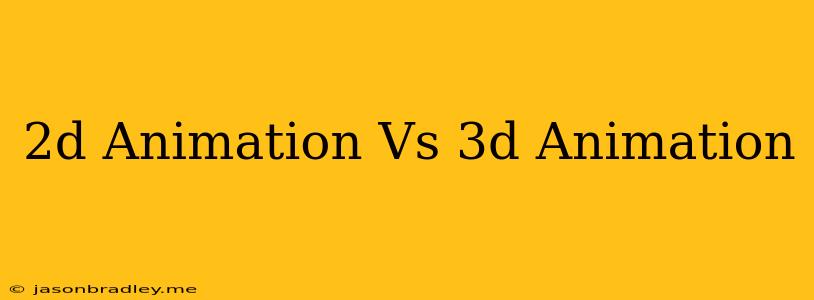2D vs 3D Animation: A Comparison
Animation is a powerful tool that can bring stories, characters, and ideas to life. While both 2D and 3D animation have their own unique strengths and weaknesses, they are both used in a wide range of applications, from movies and television shows to video games and commercials. So, how do you choose the right one for your project? This article will delve into the differences between 2D and 3D animation, helping you decide which is better suited for your needs.
2D Animation
2D animation involves creating images on a two-dimensional plane, typically using software like Adobe Animate or Toon Boom Harmony. It involves drawing, painting, or using other digital techniques to create individual frames, which are then sequenced together to create movement.
Here are some of the key advantages of 2D animation:
- Lower production cost: Generally, 2D animation is less expensive to produce than 3D animation, especially for smaller projects.
- Faster production time: 2D animation can be produced much faster, as it requires fewer individual elements to create a scene.
- Artistic style: 2D animation lends itself well to artistic styles, allowing animators to create unique and visually appealing characters and worlds.
- Classic appeal: 2D animation has a classic, timeless feel, often evoking nostalgia and a sense of familiarity.
Here are some of the limitations of 2D animation:
- Limited perspective: 2D animation is limited to a single perspective, which can make it difficult to create scenes with complex depth or movement.
- Less realistic: While 2D animation can be highly stylized, it can be difficult to achieve a fully realistic look.
- Less interactive: 2D animation is generally less interactive than 3D animation, making it less suitable for games and virtual reality experiences.
3D Animation
3D animation involves creating three-dimensional models and environments that are then manipulated and animated using software like Maya, Blender, or 3ds Max.
Here are some of the key advantages of 3D animation:
- Realistic visuals: 3D animation can create highly realistic and immersive experiences, making it suitable for movies, commercials, and video games.
- More dynamic: 3D animation allows for more dynamic camera movements and complex lighting effects, adding depth and realism to the visuals.
- Interactive: 3D animation is highly interactive, making it ideal for games, virtual reality experiences, and other interactive applications.
Here are some of the limitations of 3D animation:
- Higher production cost: 3D animation typically requires a larger team and more resources, making it more expensive to produce.
- Longer production time: Creating high-quality 3D animation can be very time-consuming, as it involves modeling, texturing, rigging, and animating complex scenes.
- Technical expertise: 3D animation requires a high level of technical expertise to create convincing and compelling visuals.
Choosing the Right Animation Style
Ultimately, the choice between 2D and 3D animation depends on the specific needs of your project.
- 2D animation is a good choice for projects that require a unique artistic style, faster production time, and lower costs.
- 3D animation is a good choice for projects that require highly realistic visuals, dynamic camera movements, and immersive experiences.
Consider the following factors when making your decision:
- Budget: 2D animation is typically more affordable than 3D animation.
- Timeline: 2D animation can be produced faster than 3D animation.
- Visual style: Consider the overall visual style of your project and whether it lends itself to 2D or 3D animation.
- Project scope: 2D animation may be sufficient for smaller projects, while 3D animation is better suited for larger, more complex projects.
No matter which style you choose, both 2D and 3D animation can be powerful tools for storytelling and visual communication. By carefully considering the advantages and limitations of each style, you can select the right animation approach for your project and achieve your creative goals.
